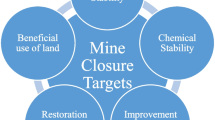Abstract
Indian coal mining industry is in transition phase with the growing demand of coal and is likely to escalate further with the need of ultra-mega power projects as well as announcement of smart cities projects. Although, there exist sufficient coal reserves in India, continuous acquisition and possession of coal bearing land is required to minimize the existing gap prevailing between coal demand and supply.The solution of the problem lies not only in modification of laws and policies of industry, but also in modification of mining engineering practices towards sustainable development. This paper critically examines the cause of the problem in the light of Indian laws and practices of the industry. In this paper a method of exact reclamation of post-mining land has been designed as a solution to make easier land acquisition by way of proposing a system of returning back the exact reclaimed land to its owners under corporate social responsibility activity of the industry. The proposed conceptual model of interlinking corporate social responsibility with land exchange will encourage sustainable development practice by mining engineers, and may turn around the public image of the industry.
Similar content being viewed by others
References
Bozeman, M.T. (2002) Underground Hard-Rock Mining: Subsidence and Hydrologic Environmental Impacts.
Central Electricity Authority, Ministry of Power, India (2015) Growth of Electricity Sector in India from 1947–2015.
Chaubey, O.P., Bohre, P. and Singhal, P.K. (2012) Impact of bio-reclamation of coal mine spoil on nutritional and microbial characteristics—a case study. International Journal of Bio-Science and Bio-Technology, v.4(3), pp.69–79.
Coal India Limited, Director’s Report 2014–15.
Coal India Limited’s Land Reclamation (2015) Report published by CMPDIL, Ranchi, 2015.
Central Mine Planning and Design Institute, Coal Inventory, 2015, http://www.cmpdi.co.in/coalinventory.php
Department of Public Enterprises, Ministry of Heavy Industries & Public Enterprises, Guidelines on Corporate Social Responsibility and Sustainability for Central Public Sector Enterprises. 2010. Department of Public Enterprises, Ministry of Heavy Industries and Public Enterprises, Government of India.
Department of Public Enterprises, Ministry of Heavy Industries & Public Enterprises, Guidelines on Corporate Social Responsibility and Sustainability for Central Public Sector Enterprises, 2013, DPE OMNo. 15(7)/2012-DPE (GM)-GL-104 Dated the 12th April. Department of Public Enterprises, Ministry of Heavy Industries and Public Enterprises, Government of India.
Environment (Protection) (Fifth Amendment) Rules. Govt. of India, 2014.
Epstein, V.J. (1987) Hydrologic and geologic factors affecting land subsidence near Eloy, Arizona. Department of the Interior, USGeological Survey.
Formulation of Corporate Plan: Coal India Limited Vision 2020, KPMG, 2010.
Government of India. 1957. Coal Bearing Areas (Acquisition & Development Act, 1957).
Government of India, Constitution (First) Amendment Act, 1951.
Hendrychová, M. (2008) Reclamation success in post-mining landscapes in the Czech Republic: a review of pedological and biological studies, Journal of Landscape Studies, v.1, pp.63–78.
Hoek, E. (1995). Surface and Underground Project Case Histories. ISBN: 978–0-08–042068-4.
Hsu, W.C., Chang, H.C., Chang, K.T., Lin, E.K., Liu, J.K. and Liou, Y.A. (2015) Observing Land Subsidence and Revealing the Factors That Influence It Using a Multi-Sensor Approach in Yunlin County, Taiwan. Remote Sensing, v.7, pp.8202–8223.
International Council on Mining and Metals, 2012.
Khanna, A. (2013) Governance in coal mining: Issues and challenges. Land Acquisition Act. Govt. of India, 1894.
Madejón, E., Doronila, A.I., Sanchez Palacios, J.T., Madejón, P. and Baker, A.J.M. (2010) Arbuscular Mycorrhizal Fungi (AMF) and biosolids enhance the growth of a native Australian grass on sulphidic gold mine tailings. Restoration Ecology, v.18 (s1), pp.175–183.
Maiti, S.K. and Ghose, M.K. (2005) Ecological restoration of acidic coalmine overburden dumps-an Indian case study, Land Contamination & Reclamation, v.13(4), pp.361–369.
Mines and Minerals (Development and Regulation) Act, 1957 (amended in 2012).
Ministry of Coal, 4th Report, Coal India Limited, April, 2015.
Ministry of Corporate Affairs, Government of India, Companies (CSR) Rules. 2014.
Ministry of Law and Justice, Government of India, Companies Act. 2013.
Morris, S. (2007) Towards reform of the land acquisition framework in India, Indian Institute of Management Working Paper, no.04.
Morris, S. and Pandey, A. (2009) Land markets in India: Distortions and issues, India Infrastructure Report.
Owen, J.R. and Kemp, D. (2014) Free prior and informed consent’, social complexity and the mining industry: Establishing a knowledge base. Resources Policy, v.41, pp.91–100.
Peng, S.S. (2006) Longwall mining, 2nd Edition.
Petkoski, D. and Twose, N. (2003) Public policy for corporate social responsibility, World Bank Institute, v.7.
Robertson, A. and Shaw, S. (2009) Mine Closure. Right to Fair Compensation and Transparency in Land Acquisition, Rehabilitation and Resettlement Act, 2013.
Sheoran, V., Sheoran, A.S. and Poonia, P. (2010) Soil reclamation of abandoned mine land by revegetation: a review, International Journal of Soil, Sediment and Water, v.3(2), p.13.
Umba, N.G. (2013) Cryptogam biomass on gold mine tailings of the Witwatersrand: identification and chemical properties (Doctoral dissertation, Faculty of Science, University of Johannesburg).
Yates, B.F. and Horvath C.L.(2013) Social License to Operate: How to Get It, and How to Keep It, Commissioned by the Asia Pacific Foundation of Canada (APF Canada) and The National Bureau of Asian Research (NBR) for the Pacific Energy Summit.
Author information
Authors and Affiliations
Corresponding author
Rights and permissions
About this article
Cite this article
Singh, P.K., Mishra, A.K. & Singh, D.R. A new model of exact reclamation of post-mining land to address land acquisition problem in Indian coal mining industry. J Geol Soc India 89, 307–314 (2017). https://doi.org/10.1007/s12594-017-0604-0
Received:
Accepted:
Published:
Issue Date:
DOI: https://doi.org/10.1007/s12594-017-0604-0




